Note: The following article contains major spoilers for COLDLINE. The game is "name your own price" on itch.io and only lasts about ten minutes, so consider working through it and coming back.
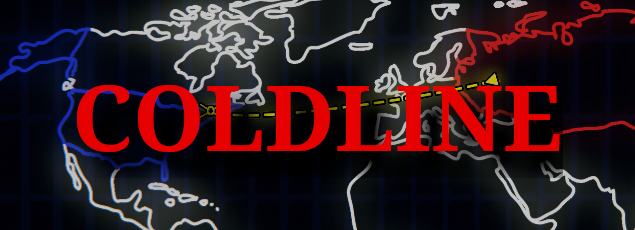
Ten. The moment that COLDLINE's gameplay starts so does the countdown. You have six hundred seconds to defuse a metaphorical bomb without knowing anything about the environment you're entering or the mechanics you'll be manipulating. Games with time limits don't always justify the inclusion of those limitations. A classic mistake in games with explicit narratives is to introduce a timer to a level to impart urgency but fail to have the narrative explain why the timer is there. In other words, the text can tell you that you need to complete a timed objective but can't tell you why it's timed. In COLDLINE, the case for the ticking clock is regrettably well made: You are the Chairman of the USSR in 1962, and your country has accidentally launched a fifty-megaton warhead on a direct course to New York City. Your only hope is to call the US President and have them intercept the missile. All you need to do to save the world is to make a perfect phone call.
Nine. COLDLINE's lean ten minutes of warning is the short fuse of nuclear warfare: a whip crack from launch to landing that kept people up at night. In a war, the rules of your life become the rules of your enemy's weapons and tactics. The siege blocks the entrances to a settlement, so the occupants have to live isolated and ration goods. The aeroplane could travel the distance of a few countries in a matter of hours, so when the bomber plane was put into production, a lot of Western Europeans had to hide in shelters and endured destruction and death even well outside of the warzone proper: the blitz.
The nuclear ICBM also disrupts lifestyles and communities. We might think of the invention of this munition and the move to "launch on warning" stances, as they were called, as enabling a hyper-blitz. You're talking about going from bombs that would yield under a ton to warheads that were rated in the megatons. A "megaton" is a measure of explosive power that is equal to one million tons of dynamite. COLDLINE's fifty-megaton missile is not fictional in that its entropic potential probably matches that of the most divine nuke ever tested: the tsar bomb. Detonated by the Soviets in 1961, the year before the game is set, tsar bomba, like the COLDLINE missile, is widely believed to have rated at fifty megatons. That's 3,800 times as powerful as the warhead the US dropped on Hiroshima.[1]
And nukes weren't just an upgrade in power, but also distance. A plane in WWII was fast, but nowhere near fast enough to reach from the Russian mainland to the US in around 25 minutes, which an ICBM could. During the Cold War, the citizens of the USA, the Soviet Union, and their allies lived at the speed of the nuke's flight. The knowledge that cities could be wiped off of the map with mere minutes' notice made it impossible to exhale, motivated paranoid irrationality about where enemies were and the acceptable recourse to stop them, and moved militaries to enter states of hair-trigger readiness. The President began carrying around a satchel of launch codes, for god's sake. One of the most enduring images of the Cold War was that of the Doomsday Clock: a yardstick for humanity's existential precarity created by Einstein and key figures from the Manhattan Project. Its metric "minutes to midnight" implies that even on a good day, you are a short commute from some black finality.
Eight. I think living in that state of morbid anticipation for years on end warped some boomers' brains. Dwelling in the constant expectation of violence tends to leave expectants unable to leave that anxiety behind. If middle-aged or elderly Westerners or Russians seem overly susceptible to red scare or unfounded hints of incoming nuclear flocks, that's no doubt down to years of nationalist and military propaganda. However, it's also what happens when you live years of your life knowing that any ten minutes could be the ten minutes of COLDLINE. It leaves our culture reflexively returning to the adrenaline fear of the Cold War, even long after we've left the event itself behind, creating media like this game.
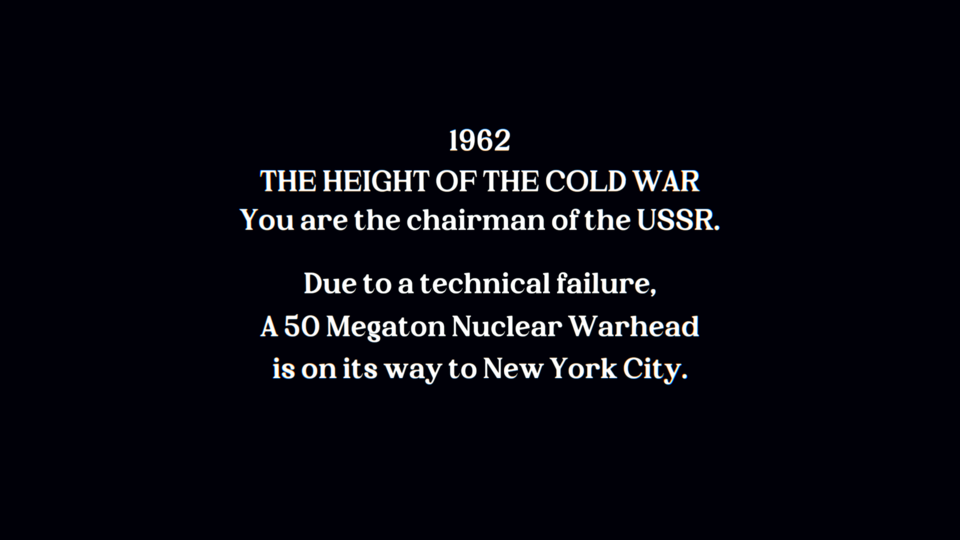
This has gotten pitch dark, so maybe we could use some levity because this is also a comedy game. That might sound outside the realms of possibility; the problem the game presents is as bleak as it gets. The solution to this problem is also disturbing, but it is ridiculous. When your call is connected to the White House, it's answered by one of those automated customer service systems. You must climb a phone tree to prevent the apocalypse, and as we all know, those menus are insultingly slow and barely navigable. The gag that developer papercookies pulls here is partly in the pleasant roboticism of the prerecorded voice that accompanies you through the worst scenario imaginable. It's partly that papercookies made the whole game out of the settings screen. But it's also the mismatch between the tool and the work. COLDLINE is trying to eat your soup with a fork or wrap a present with the lights off. The game gets across the turtle crawl these telephonic systems move at by having you call one at the moment you most need someone to respond with haste.
Seven. You've no doubt experienced media that is grim at some points and funny at others, but COLDLINE is both at the same time. And it wouldn't get across dread or comedy if it didn't have a realistic grasp of just how disastrously designed phone menus are. One reason designers present users with written text instead of the spoken word is that the former accounts for different users processing language at different speeds. Of the people who can read, some do it faster than others, and if you've already visited a piece of written text, you can skip over parts you've memorised to get at the information or options you need. That's not the case in an auditory medium that forces you to parse at its rhythm. And naturally, the faster the tempo of speech, the more people you exclude from being able to interface with your systems. Therefore, the creators of phone menus sedate their speed.
Not only does this sluggish pacing test callers' blood pressure, it also encourages them to leapfrog over menu nodes without hearing all the options because they want to get where they're going now, not in half a minute's time. This behaviour increases the chance they'll barge into the wrong room of the menus and have to backtrack, wasting more time. We can imagine a system that finds the right pace for each user, allowing them to save their preferred speech speed, and maybe also, which menu options they've heard recently, but per COLDLINE, that's rarely the system we get. To save and retrieve your user data, you need a unique login, and that's probably a tattered scrap of paper hidden at the bottom of a drawer.
Even without saves, designers can limit a caller's exposure to the same soul-draining speeches by designing an efficient menu that stops the caller from visiting one node more times than they need to, but how often do you encounter one of those? I called these menus "labyrinths" up top because they are composed of nodes that each have points of entry and exit that can only be reached via other specific nodes. Replace the word "nodes" in that previous sentence with "rooms", and you have a description of a building. Really, any space is a series of points where each point has access to adjacent points but not non-adjacent points. So, I say menus are spatial, and I've not argued with me yet.
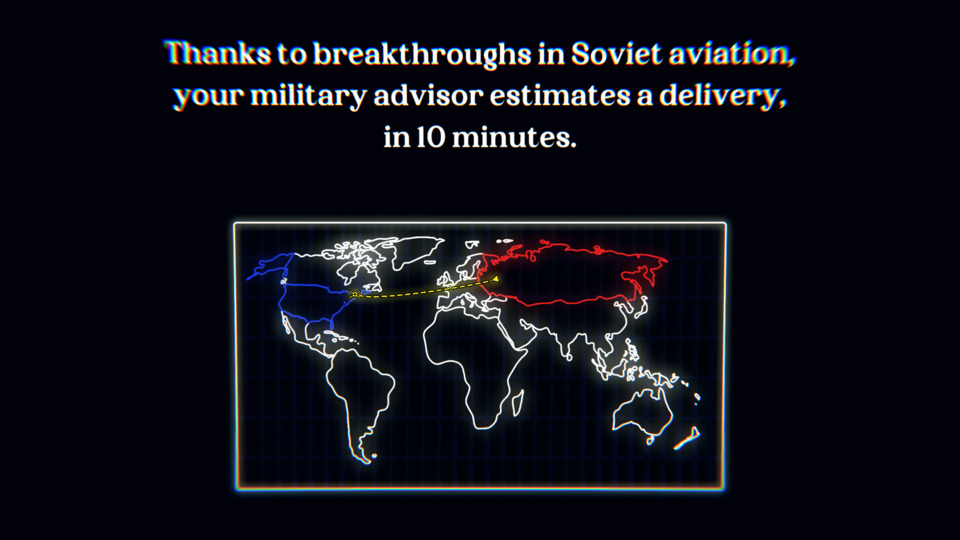
Six. Like many spaces that are frustrating to navigate, phone menus are understocked with direct routes between points the user is likely to want to move between. In their place, we get extra stops blocking the path from node A to node B, each with its own little speech and protocols like you're being processed by port authority. Here are a few familiar examples of direct navigation being impossible, as presented in COLDLINE:
- Being able to move down a level in the menu hierarchy but not up. If you think of the phone menu like a Windows directory tree, you could progress from C:/Program Files/ to C:/Program Files/WinRAR/, but you couldn't backtrack from C:/Program Files/WinRAR/ to C:/Program Files/.
- Being unable to cancel out of "hold". The user cannot predict how long they will be on hold before getting into this configuration, and so, cannot tell whether it will be faster to try and talk to a person or continue menu navigation. Once they've found out that hold is a time sink, they have no ejector seat from it.
- Being unable to jump "sideways" through the menu tree. For example, in COLDLINE, there is a menu from which you can order a nuclear interception, but the codes you'd need to request the correct interception method are hidden in another menu, both of which branch down from the main menu. There is no door between the interception menu and the codes menu.
The prying stick to clear any of these logjams is to admit defeat and go back to square one: the main menu, often the farthest point from your destination. Automated phone systems are a bit like Getting Over It with Bennett Foddy. COLDLINE and the trees it depicts are also like other poorly designed spaces in that they're often poorly signposted. For instance, any number of services we need to access might hide in the inscrutable raffle of "More options". Or clicking the auditory link to learn more about offensive nuclear weapons may not actually help you find the code for your offensive nuclear weapon.
A bad tool makes us work harder to compensate for its weakness. A blunt knife forces us to cut with a firmer hand; if a cable frays, we must replace it; if phone menus can't clearly tell us where an option will go, we're forced to do the labelling for them. One of the jobs of a UI is to remember for us: store our points count, the item in our left hand, or the paths ahead from our current location so we don't have to memorise this data. When UIs don't remember, we have to write all that overwhelming information to our grey matter. With the White House's automated receptionist being so lazy, we must build the menu tree in our heads to get anywhere, and it makes me feel like my skull's about to burst.
Five. The existence of any phone menu in COLDLINE is, of course, an anachronism, one blatant enough that it reads as symbolic. The red phone piercing through the centre of the screen sticks out like a bloody injury of the timeline. Like most symbols, the automated system can stand for a few different things. For one, it uses the incompetence and miscommunication of customer service systems to discuss where the same themes may arise in the management of atomic arms.
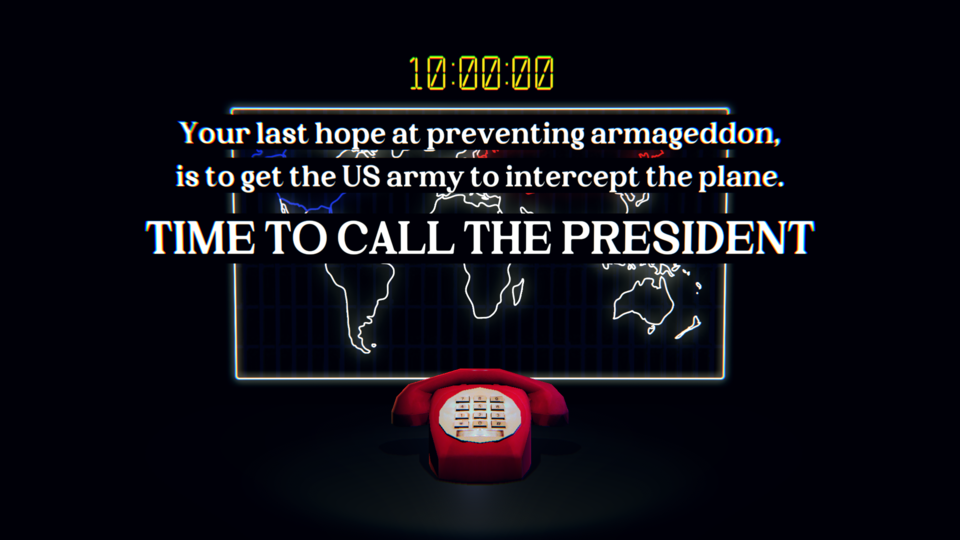
The ubiquitous image of nuclear threat in the West has been one of a commissar foaming at the mouth with his finger on a big red launch button. But as I touched on when talking about the RTS, DEFCON, the reality of nuclear close calls has not been one of malicious volition. It's been a cavalcade of improperly issued orders, misunderstandings, and computer glitches. The speed at which the nuke can sprint towards your door motivates militaries to ready retaliations that place response time over the lengthy process of verification. And while the premonitions of psychologically brittle Soviet generals were used to manufacture consent for permanent nuclear readiness, I also think those images have been used to comfort. There's a humanity in being killed by the commander of a nuclear stockpile; at least someone got to exercise their ambitions. The alternative: being vaporised in your chair by a domino chain of protocol failures is more like sketch comedy. One is Hannibal pointing his sword towards the mountains and letting loose a cry to slaughter. The other is the world ending because your cat knocked your Pepsi onto your laptop.
COLDLINE is also comparing disorganisations of East and West. In the West's review of the Soviet Union, the country's sin was as much inefficiency as it was human rights violations. According to the capitalists, the free market is overclocked to give you what you want when you want; in the USSR, it was all formal requests for formal requests and psychosis-inducing wait times for bread. But in COLDLINE, we make a telephone call westward and find the same frictional bureaucracy awaiting us in the capitalist system. In gentle tones, a gremlin in the wires tells us that our call is "very important" to them, but how important can it be when we are stuck in this mirror maze of menu prompts? If we must spend an eternity on hold to book doctor's appointments or get our electricity turned back on, is Western capitalism really the efficient alternative that we were promised?
Also represented in our phone call: the speed of international relations lags well behind the pace at which global crises proliferate. Genocides are waged faster than assemblies can agree on a plan of action to condemn them, let alone stop them. Arming yourself with unimaginably cruel weapons takes a few weeks, but ratifying peace treaties seems to take a lifetime. This order in which violence comes first and peace comes second is the wrong way around, just as, for Westerners, everything in COLDINE is backwards. We don't see the Cold War from the perspective of the North Americans or Europeans; we see it from the perspective of a Soviet. The Chairman of the USSR doesn't make the call to launch the arsenal but to stop it. It's not a hotline; it's a COLDLINE. We expect frenzied celebration from a Soviet Union launching a nuclear payload but are reminded that the country didn't want to launch anything at all.
Four. Societies can benefit from wars, but not global thermonuclear war. Wars abroad can be useful for extracting resources or reordering the world so that you come out on top. Any direct damage happens to someone else's country. War in your nation incurs more collateral, but to some, civil war or revolution has been desirable because your country could be in an improved state post-war or post-revolution. The hellfire of the ICBM changed the whole game. Nuclear war would take place in your country, no matter which side you were on or where you were. The theatre of war had been expanded so that the same battle could be happening in Washington, DC, and Moscow. And it would render your whole country, even the planet, scarcely inhabitable in the aftermath. A 2020 study found that even a nuclear exchange between the relatively modestly armed India and Pakistan could cause a famine that would kill 2 billion. Even as world leaders set up the scaffolding for nuclear armageddon, they knew they could never cut the ribbon. Yet, that didn't mean they had a solid plan that would avert the war either.
Three. COLDLINE, set in 1962, is an echo of the '62 communications between John F. Kennedy and Nikita Kruschev to defuse the Cuban Missile Crisis.[2] The Cuban Revolution took place in 1959, axing the dictator Fulgencio Batista. Shattered by Batista's authoritarianism and the long rule of colonialism before it, Cuba stood with few pennies to its name. It reconstructed itself with communist principles and aimed to revatlise its economy by forming a financial relationship with the major, ostensibly socialist world power at the time: the Soviet Union.
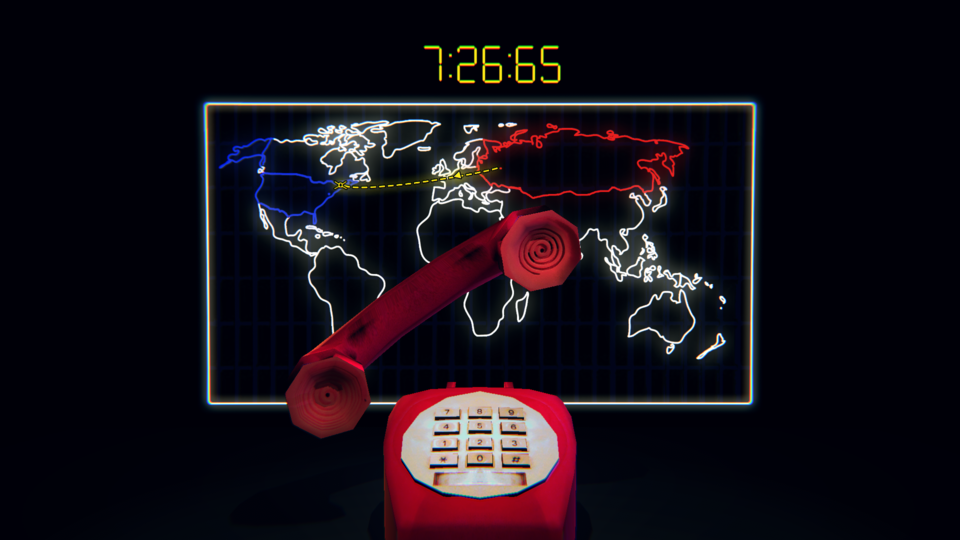
In the 50s, the US placed nuclear warheads in Europe aimed at the USSR, including a deployment of nukes in Turkey in 1959. The western border of the Soviet Union felt the hot breath of Uncle Sam. Back west, the United States would oppose socialist uprisings all over Latin America but was particularly alarmed by islands so close to them financially allying with an enemy and embracing anti-capitalism. Their response was repeated assassination attempts on Cuban leader, Fidel Castro, acts ofterrorism inside Cuba, and in 1961, a bungled invasion of the country. So, now Cuba was motivated to defend itself against the Americans, and the USSR wanted to station bombs close to a United States that had done the same thing to them. The mutually agreeable arrangement was for the Soviet Union to ship the parts for weapons of mass destruction to Cuba. So they did, and the Cubans began assembling their nukes 90 miles south of Florida.[2]
Two. You might think the US would treat this atomic mousetrap with some care, but Kennedy's military chiefs wanted to shove their hands right in, pushing for an air attack on Cuba, and, if necessary, a second invasion. Fearing that directly engaging a country with nukes could lead to a launch, President Kennedy opted for a blockade of Cuba instead, although he publicly threatened a second invasion.[2][3] Kruschev declared the blockade an act of aggression and emphasised the potential for a nuclear skirmish to break out. The US's strategic air forces prepared for war, for the first and only time in history moving to DEFCON 2. It's also around here that we get the close-miss launch of nuclear armaments from Soviet sub B-59, granted by two military officers but averted by another.
But then, something strange happened: Kruschev and Kennedy came to the negotiating table. The two agreed that if the Chairman withdrew the nukes from Cuba, the US would never invade the nation again and would remove its batteries from Turkey. On the record, the US would say it did not capitulate to demands to remove its missiles.[2], but each country upheld its end of the bargain. The following year, the so-called "red phone" was installed: a direct line from Moscow to Washington that could be used to diplomacise through future conflicts.[4]
The apocalypse was averted, but only just. The time scale of the Cuban Missile Crisis is shocking. The catastrophe took place over just thirteen days, but prior to the introduction of the red telephone, it could take hours for the US to send the USSR one message or vice-versa.[4] And when it came to trying to lull the global order back into a state of relative peace, both Kennedy and Kruschev were also racing military chiefs eager to enter the room bayonets-first and potentially provoke ICBM deployments. COLDLINE is the fear that formalised diplomacy might be too slow to save us from mass extinction. Even the Doomsday Clock could not always keep pace with contemporary threats. During the Missile Crisis, it did not move closer to midnight, a subject of common criticism. The Bulletin of Atomic Scientists maintains that too little was known about the conflict at the time to make an accurate update.[5]
One. Since 2007, the clock's setters have expanded its mission. No longer simply a prediction of how close we tip-toe to a nuclear conclusion, it is now also a spittle-soaked thumb in the air of general existential risk.[5] During the Cold War, the closest the clock came to midnight was two minutes. It reached this setting in 1953, the year of the first hydrogen bomb test, but this is not the closest it flirted with midnight overall.
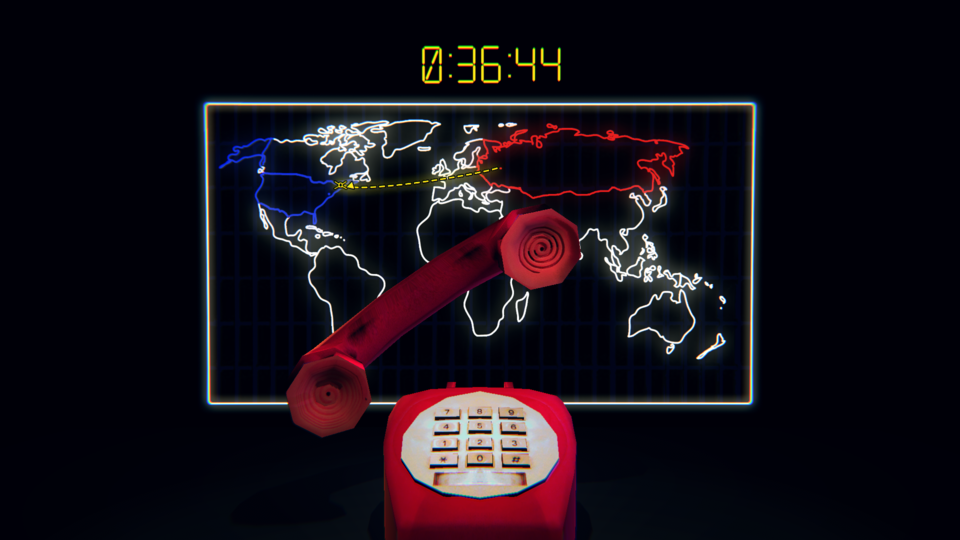
In 2023, the Bulletin moved the Doomsday Clock to one minute and thirty seconds to midnight, citing the potential for nuclear ignition in the Russia-Ukraine war, as well as international failures in preventing the COVID-19 pandemic and human-made climate change. It's not the case that there haven't been global assemblies vowing to guard us from these restructuring events. The UN was founded in 1945, the World Health Organisation was set up three years later, and the first World Climate Conference was held in 1979. But wars and viruses travel faster than diplomacy, and while a response to the environmental collapse and a contingency for the next international epidemic are beyond urgent, navigation of these issues has been painfully slow. As it stands, we're still on hold. Thanks for reading.
Notes
- Tsar Bomba by Amy Tikkanen (August 10, 2017), Britannica.
- Cuban Missile Crisis by History.com Editors (January 4, 2010), History.
- JFK vs. the Military by Robert Dallek (September 10, 2013), The Atlantic.
- Hotline established between Washington and Moscow by History.com Editors (November 16, 2009), History.
- FAQ by Kennette Benedict (Date Unknown), The Bulletin of Atomic Scientists.
All other sources linked at relevant points in article.
Log in to comment